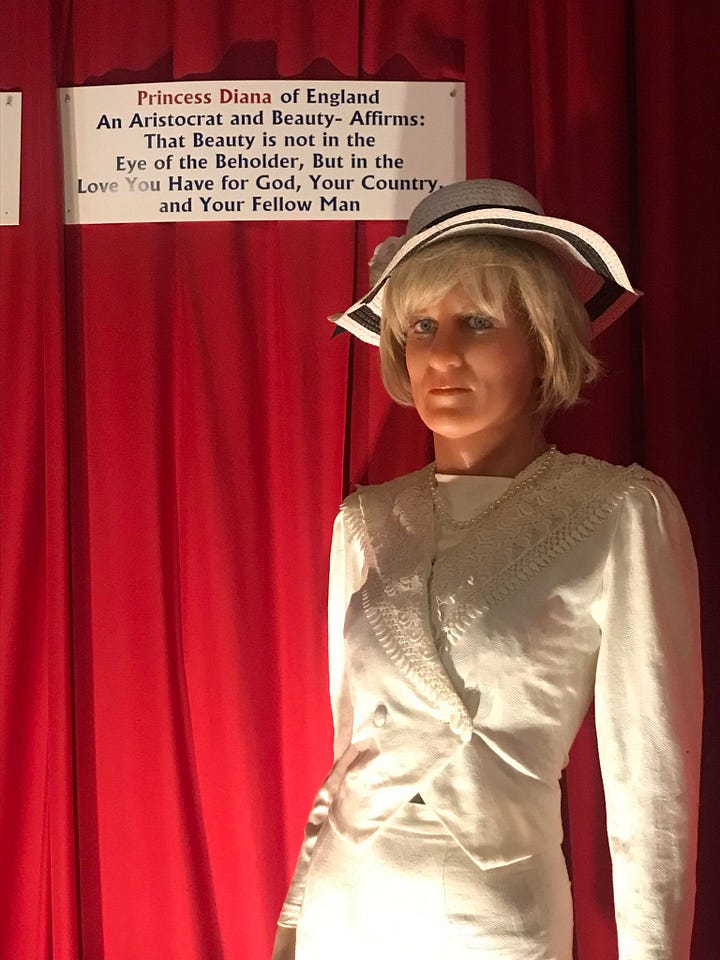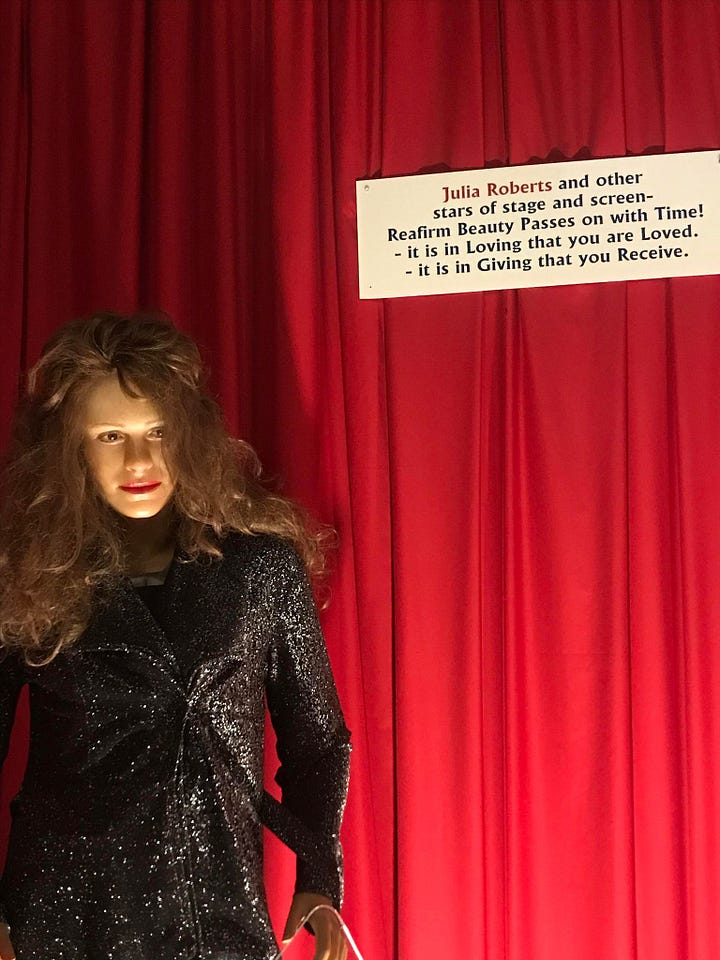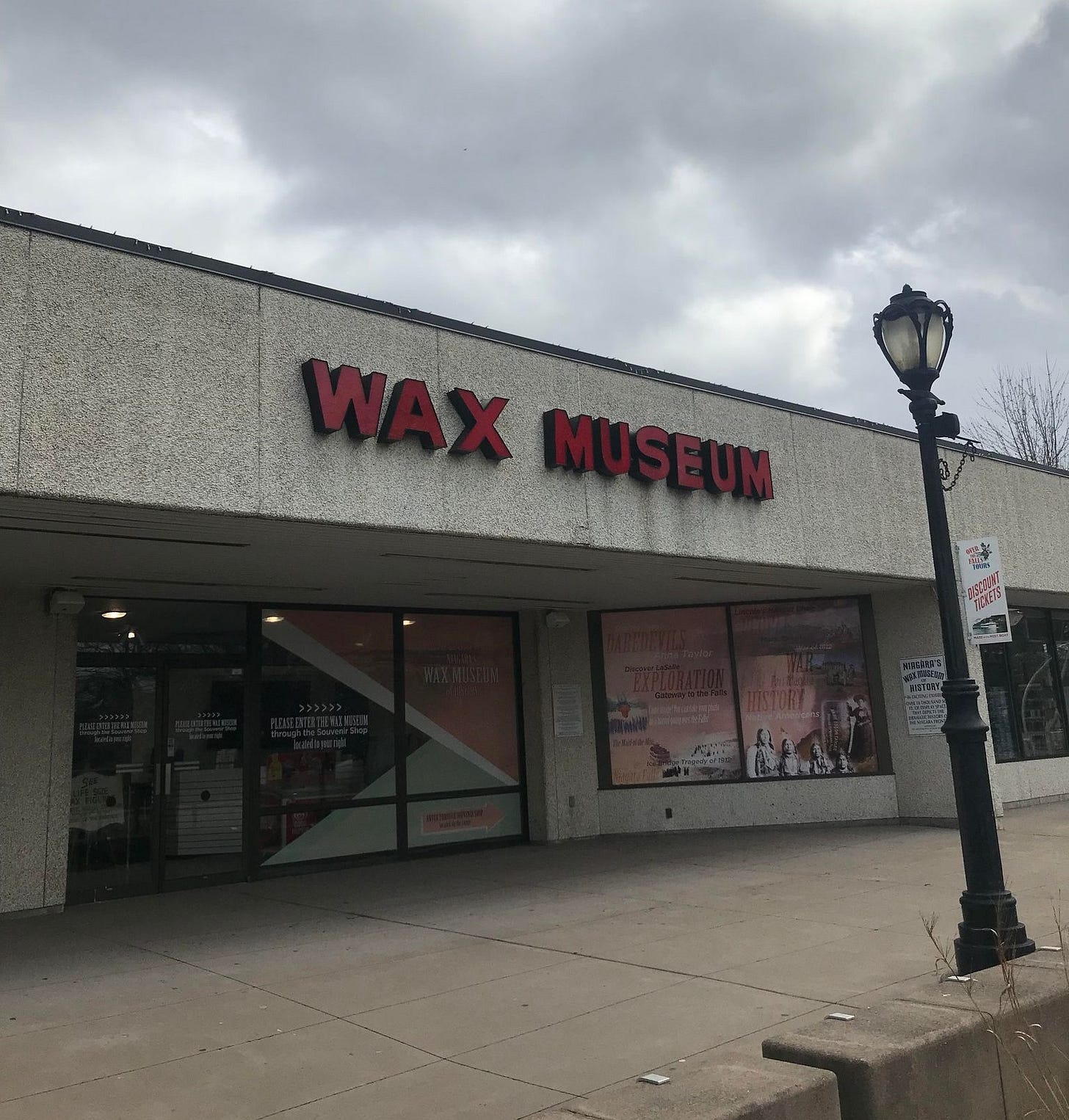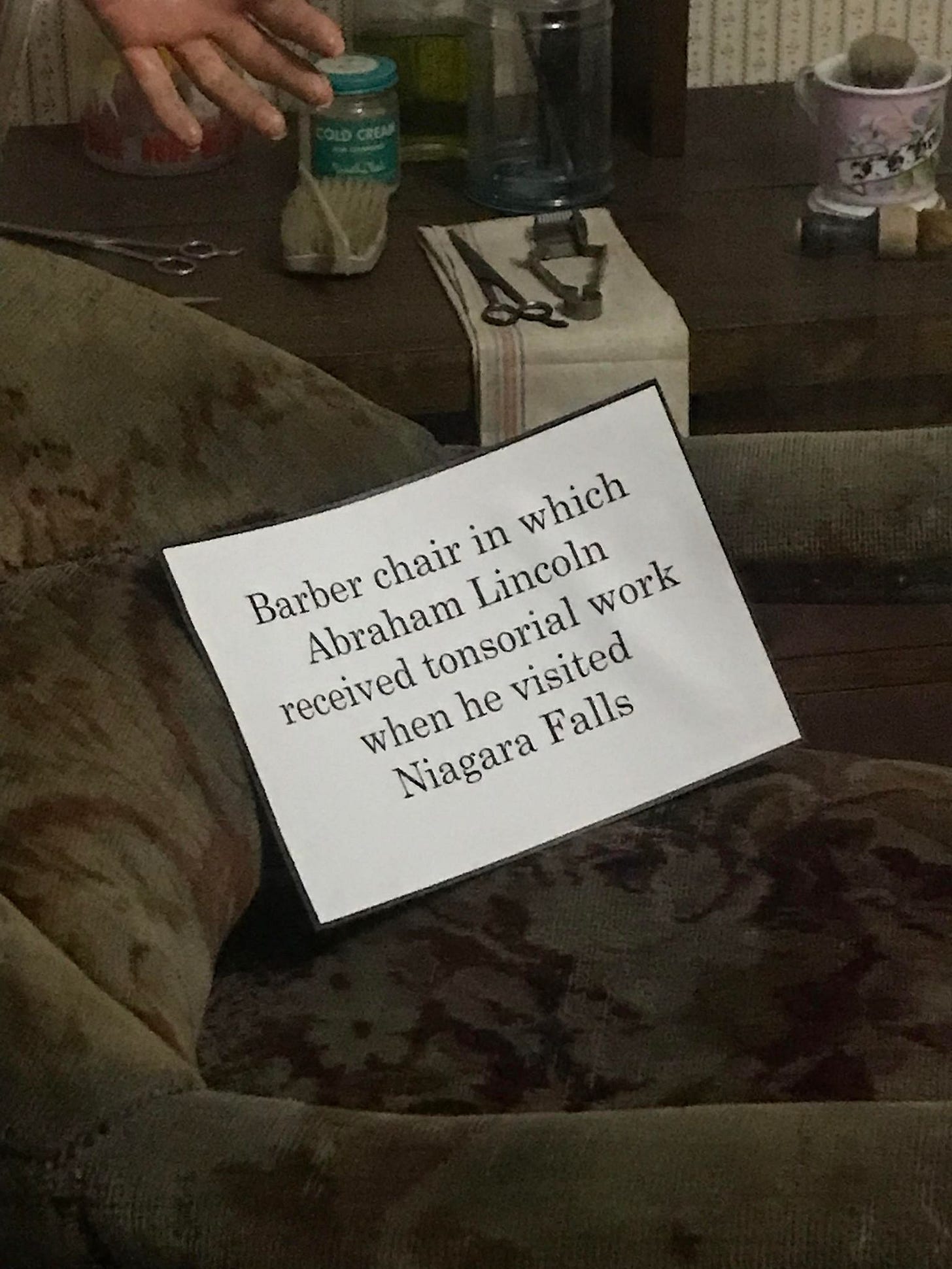What's the deal with wax museums?
I paid $5 to see a Princess Diana waxwork that looked like Sean Penn.
I’d never been to a wax museum before. Madame Tussauds never appealed to me when I’d visited London, I didn’t understand why you would want to pay to go and look at a wax version of Beyonce or Madonna. However impressive or realistic the artists got their likeness it was never quite right, always something uncanny and wrong about they eyes and mouths. If I wanted, for whatever reason, to look at Madonna I could just go on google images and see her in every era, at every age, or go to Youtube and see actual moving footage of her performing or talking in interviews. I don’t even like Madonna like that, but I could.
When I visited Niagara Falls (USA not Canada, important distinction) earlier this year, for an academic conference I was largely ignored at, I was struck by the complete lack of things to do on my days off from the conference. I was in town out of tourist season and everything was closed apart from the gargantuan casino sat in the middle of town like a foreboding monolith and a Nepalese restaurant I ate at five times, exhausting their vegetarian menu.
After seeing the falls twice one of the only things left to do was visit the ‘historical wax museum’ which sat next door to a deserted Hard Rock Cafe.
I’d seen adverts for Madame Tussauds before with it’s well-lit statues and red interior giving a sort of camp glamour to the whole thing and thought that was what I was going to get here, but with Abraham Lincoln instead of Justin Bieber.
My partner and I were the only visitors, a good sign. After we paid for our $5 ticket in the gift shop that was inexplicably full of 4/20 and weed-themed items we were pointed towards what looked like a back door and stepped into the magic.
The museum was insane. I was honestly blown away by the experience. My partner and I couldn’t stop laughing and since we were the only ones there, it didn’t matter. Most of the wax works depicted historical scenes from American, specifically Niagara Falls’, history - so think soldiers, generals, and questionable portrayals of Native Americans. There were a few figures we recognised: a sad-looking George Washington in what looked like a Halloween wig from Tesco, I turned a corner to a sudden Mark Twain in a rocking chair (he looked like if you crossed Edgar Allan Poe with Einstein and then slapped him).
Most of the wax works here looked only tangentially like their models, with highlights being an appalling Julia Roberts with hair like a Bratz doll forgotten in the bottom of a wardrobe for six years and a Princess Diana that shared a striking resemblance to Sean Penn. Why were they featured in a Niagara Falls historical wax museum? Because they visited one time, that is almost literally what their exhibition cards said.


Alongside these gems were some bizarre supplementary exhibits, like a ‘Hall of Presidents’ which was just a room with A4 paper print out pictures of each American president lining the walls. Or a chair that Abraham Lincoln supposedly got his tonsils removed in.
It was well worth the $7 admittance fee for the hilarity alone, but walking around got me thinking about the point and place of wax museums in 2023 when most celebrities are just a few clicks away on Instagram. They seem like a strange cultural hangover from days gone by, something being kept afloat purely by the kitsch appeal, like M&M world or TGI Fridays.
But celebrity wax works are still a big deal, especially when a new one is unveiled or one gets removed from display. Just last month seven (7!!!!!) new wax works of Harry Styles were revealed at Madame Tussauds in London, seeming to solidify his mega-star status. There’s even a bizarre video of fans serenading these statues with Styles’ songs. A few years ago there was fanfare about the first wax works of influencers being revealed at Madame Tussauds. Zoe Sugg and Alfie Deyes were immortalised in wax in 2015, which is just the most 2015 thing to ever happen, in a move that seemed to suggest their transition from internet fame to broader stardom. There have since been a few other influencer and even TikToker wax figures unveiled in various musuems around the world, but despite the current influencer-to-celebrity pipeline there is not really a TikTok-to-Tussauds pipeline to match.
Perhaps this is due to the transience of internet fame, trends change much quicker and there is always the danger that someone could be cancelled at the drop of a hat, their wax figure needing to be melted down under the cover of night and reformed into the next viral sensation by morning. It all sounds a bit much. Even if George Clooney was cancelled on Twitter there would still be hoards of middle aged mums queuing up to take a photo with his wax visage, blissfully unaware.
In a world where you can tweet directly at someone or kick off at them in their Instagram comments, communications that the celebrity is far more likely to see in real time, there is still nothing quite as visceral, as brutal-feeling, as going and scratching the eyes out of a wax-effigy of your celebrity nemesis. As absurd as it might seem to take your frustration out on a wax work, it certainly gets the message across. In recent years we’ve had people attacking Donald Trump’s waxwork and the iconic Just Stop Oil defacing (the then) Prince Charles’s effigy with a cake in protest at the lack of climate change action. I wonder how it feels to not only know that people despise you enough to shout or tweet abuse at you, to not just deface or cruelly edit photos of you for protests, but to actually physically damage your lifelike effigy?
Wax works as we know them today grew from the funeral practices of European royalty - in the medieval period it was the pracitce to carry the corpse atop the coffin so the deceased could be viewed by their subjects prior to the funeral. However, bodies weren’t always in great shape at the time of death or external conditions like summer heat meant that it was unsightly and unwise to keep bodies on display - thus grew the custom of the wax effigy. Often these effigies were kept on display after the funeral and people could pay to view them. Even after the practice of carrying the effigy on the coffin ended wax statues were still made of the deceased to be displayed following the funeral. Charles II’s funeral wax work was on display from the 1680s until the early 19th Century. The French even took it to a higher level of artistry, as they are wont to do, creating posed wax figures in detailed tableaus.
I wonder what the future will be for wax museums. It seems a shame to lose these places, even if a large part of their draw now remains tied to their camp appeal. Also, clearly the artists that work for such museums are immensely talented - I may have bashed the Niagara Falls Diana but I’d have made her look like a Teletubby. At a time when so many skilled professions have died out it would be a shame to lose another, however niche it may be. In the UK iconic historic wax musuems in Great Yarmouth and Edinburgh have closed and all is left are the two Madame Tussauds locations in Blackpool and London. Yes, Great Yarmouth’s wax museum was renouned for its sublimely atrocious statues, but at least it was an experience that differed from the glossy homogenisation of Madam Tussauds.
Madame T probably isn’t going out of business any time soon as there’s clearly still a thirst for the glassy-eyed stare of your favourite actor. The cult of celebrity is powerful, this is nothing ground breaking to say. We like to look at famous peple, love it even, and a wax work gives us the chance to do that as long as we want (within opening hours of course) without the risk of a restraining order. But so does Instagram.






